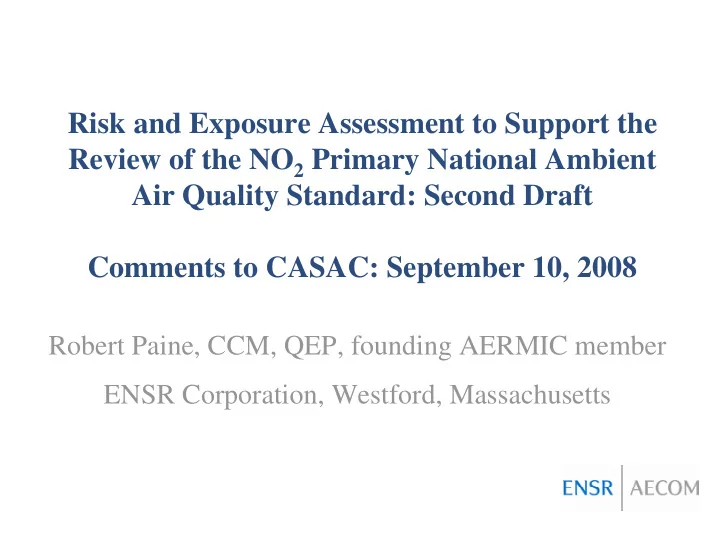

Risk and Exposure Assessment to Support the Review of the NO 2 Primary National Ambient Air Quality Standard: Second Draft Comments to CASAC: September 10, 2008 Robert Paine, CCM, QEP, founding AERMIC member ENSR Corporation, Westford, Massachusetts
Outline of Presentation – Concerns about the NO 2 NAAQS review process – Problem with roll-up for peak 1-hr NO 2 concentrations – Example of correction to the roll-up procedure – Concerns about exposure modeling analysis – Modeling limitations for 1-hr NO 2 and roadway emissions 2
NAAQS Review Process Is Being Compromised – The air quality modeling is a key element of the REA and belonged in the August draft, BUT…. – Information provided on September 9 is highly incomplete, and did not support the conclusion of September 8, 2008 Graham memo: “…we feel that these improvements to the model inputs, and given our current understanding of model performance, that the updated AERMOD modeling results should provide adequate estimates of hourly air concentrations for input to the risk and exposure assessment to support the review of the NO2 primary NAAQS”. – The optimistic 2-week estimate to conclude the work and report to CASAC (September 23) is only 3 days before the public comment period ends for the second draft REA 3
Method to Determine Peak 1-hr Conc. When Just Meeting Current Annual NO 2 NAAQS – Invalid – The peak-to-mean ratio developed is assumed to be linear; this results in large errors for a reactive pollutant like NO 2 – Resulting errors affect all results in the Risk Assessment for peak 1-hr conc. based on “just meeting” annual NAAQS – Corrected roll-up indicates that current annual standard is more protective than indicated in the Risk Assessment 4
Ratio of 2 nd High 1-Hr NO 2 to Annual Average NO 2 versus Annual Average NO 2 (2007) Shows Strong Negative Correlation 100.00 10.00 1.00 0.0001 0.001 0.01 0.1 Annual Concentration (ppm) 5
Example Correction to NO 2 Roll-up Method – Regression analysis of 10 years of NO 2 monitoring data • Uses 1998-2007 monitors with > 90% data capture • 2 nd high 1-hr to annual peak-to-mean ratio adjusted based upon plotted regression line • Implication: when the annual average NO 2 is increased, the peak 1-hour concentrations also increase, but not linearly • Results of correction for 2007 monitoring sites exceeding 25.6 ppb (level used in the 2 nd Draft REA) Number of Monitors with Second-high 1-hour NO 2 Exceeding Estimation Method 150 ppb 200 ppb 250 ppb 300 ppb Roll-up 9 1 0 0 Corrected 1 0 0 0 6
Concerns about Exposure Modeling – General issue: roadway sources have peak NO 2 impacts, but modeling approach / accuracy is highly uncertain – Philadelphia • Of 3 monitors evaluated, 2 are > 1000 m from major highway, one is about 200 m away • Calibration method of adjusting modeled concentrations by adding the average difference monitor-model is “unacceptable” (App. W) • Model performance for 2003 is markedly inconsistent in comparison to 2001 and 2002 and should be further investigated • Philadelphia Airport emissions from aircraft appear to be underestimated by a factor of 10 – Atlanta • Initial peak NO 2 predictions too high by factor of 2 • Distances of monitors from highway ranges from 350 to over 1000 m 7
Limitations in Modeling Short-Term NO 2 and Roadways – Mobile sources are very important, but there is virtually no applicable AERMOD evaluation, especially in urban areas – Vertical dispersion of roadway sources is underestimated – there is substantial turbulence with traffic flow not modeled – Geometry is critical – wind flow along or across roadway – significantly affects off-roadway concentration gradient – Short-term emission estimates are very challenging – Short-term ozone concentrations are critical; how to allocate available ozone to multiple sources still a question – Many of these problems are not as critical for annual average modeling as they are for short-term modeling 8
Overall Conclusions – The comment period need to be extended; there is not enough information available to the public at this time – Short-term estimates based on a peak-to-mean ratio using “just met” annual averages are too high – For short-term NO 2, concentrations, AERMOD has limitations due to complications with roadway sources - modeling procedures still being developed and tested – In urban areas, AERMOD evaluation is very limited, especially for roadway sources – In Philadelphia and Atlanta, monitors are at least 200 m from major roadways – no test of critical 100-m zone – Sept 08 results for any short- term NO 2 evaluation using AERMOD are likely to be preliminary and misleading 9
Recommend
More recommend